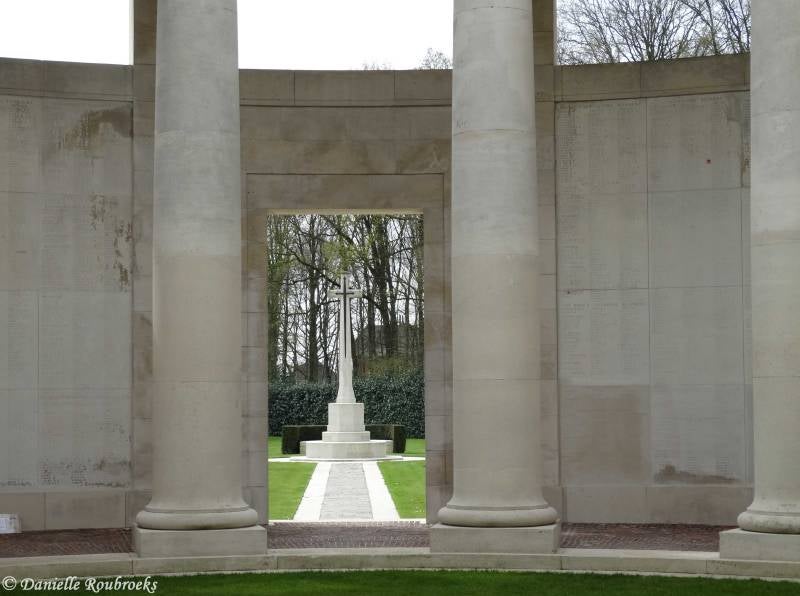Ploegsteert Memorial
The Ploegsteert Memorial, commemorating more than 11,000 Commonwealth servicemen who died in this sector during the First World War and have no known grave. The memorial serves the area from the line Caestre-Dranoutre-Warneton to the north, to Haverskerque-Estaires-Fournes to the south, including the towns of Hazebrouck, Merville, Bailleul and Armentieres, the Forest of Nieppe, and Ploegsteert Wood.
Those commemorated by the memorial did not die in major offensives, such as those which took place around Ypres to the north, or Loos to the south. Most were killed in the course of the day-to-day trench warfare which characterised this part of the line, or in small scale set engagements, usually carried out in support of the major attacks taking place elsewhere. The memorial was designed by H Chalton Bradshaw.
VICTORIA CROSS
Sapper William HACKETT - 136414 - 254th Tunnelling Coy. Royal Engineers
Died 27 June 1916 Age 43
Country of Service: United Kingdom
Awards: Victoria Cross
Citation
An extract from "The London Gazette," dated 4th Aug., 1916, records the following:-"For most conspicuous bravery when entombed with four others in a gallery owing to the explosion of an enemy mine. After working for 20 hours, a hole was made through fallen earth and broken timber, and the outside party was met. Sapper Hackett helped three of the men through the hole and could easily have followed, but refused to leave the fourth, who had been seriously injured, saying," I am a tunneller, I must look after the others first." Meantime, the hole was getting smaller, yet he still refused to leave his injured comrade. Finally, the gallery collapsed, and though the rescue party worked desperately for four days the attempt to reach the two men failed. Sapper Hackett well knowing the nature of sliding earth, the chances against him, deliberately gave his life for his comrade".
Grave Reference: Panel 1.
(Source: Wikipedia)
Private James MACKENZIE - 8185
2nd Bn. Scots Guards
Died 19 December 1914 Age 27
Country of Service: United Kingdom
Awards: Victoria Cross
Citation
An extract from "The London Gazette," dated 16th Feb., 1915, records the following:-"For conspicuous bravery at Rouges Bancs on the 19th Dec., in rescuing a severely wounded man from in front of the German trenches, under a very heavy fire and after a stretcher-bearer party had been compelled to abandon the attempt. Private Mackenzie was subsequently killed on that day whilst in the performance of a similar act of gallant conduct."
Grave Reference: Panel 1.
(Source: Wikipedia)
Captain Thomas Tannatt PRYCE - 4th Bn. Grenadier Guards
Died 13 April 1918 Age 32
Country of Service: United Kingdom
Awards: Victoria Cross, Military Cross and Bar
Citation
An extract from "The London Gazette," dated 21st May, 1918, records the following-"For most conspicuous bravery, devotion to duty, and self-sacrifice when in command of a flank on the left of the Grenadier Guards. Having been ordered to attack a village he personally led forward two platoons, working from house to house, killing some thirty of the enemy, seven of whom he killed himself. The next day he was occupying a position with some thirty to forty men, the remainder of his company having become casualties. As early as 8.15 a.m., his left flank was surrounded and the enemy was enfilading him. He was attacked no less than four times during the day, and each time beat off the hostile attack, killing many of the enemy. Meanwhile the enemy brought three field guns to within 300 yards of his line, and were firing over open sights and knocking his trench in. At 6.15 p.m., the enemy had worked to within sixty yards of his trench. He then called on his men, telling them to cheer and charge the enemy and fight to the last. Led by Captain Pryce, they left their trench and drove back the enemy with the bayonet some 100 yards. Half an hour later the enemy had again approached in stronger force. By this time Captain Pryce had only 17 men left, and every round of his ammunition had been fired. Determined that there should be no surrender, he once again led his men forward in a bayonet charge, and was last seen engaged in a fierce hand-to-hand struggle with overwhelming numbers of the enemy. With some forty men he had held back at least one enemy battalion for over ten hours. His company undoubtedly stopped the advance through the British line, and thus had great influence on the battle."
Grave Reference: Panel 1.
(Source: Wikipedia)









































